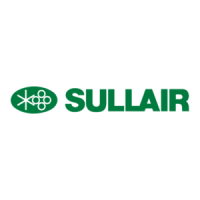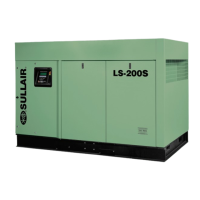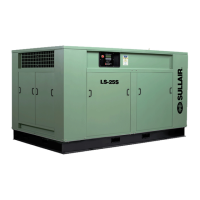Section 2
DESCRIPTION
9
er and is directed towards the bottom of the sepa-
rator element. The direction of movement is
changed anditsvelocity significantly reduced, thus
causing large droplets offluidtoseparate andfallto
thebottom ofthe receiver/sump. Thefractional per-
centage of fluid remaining in the compressed air
collects on thesurface of the separator element as
the compressed air flows through the separator.
Return lines (or scavenge tubes) lead from the bot-
tom of the separators’ elements to the inlet region
of the compressor unit. Fluid collecting on the bot-
tom of the separator is returned to the compressor
by a pressure differential between the receiver and
the compressor inlet. Visual sight glasses are lo-
cated on the return lines to observe the fluid flow.
There are also orifices in the return line (protected
by strainers) to assure proper flow. A gauge, lo-
cated on the instrument panel, shows red if abnor-
mal pressure drop through the separators devel-
ops. At this time, separator element replacement is
necessary.
The receiver is ASME code rated at 175 psig (12.1
bar)workingpressure. A minimumpressure/check
valve, located downstream from the separator, as-
sures a minimum receiver pressure of 55 psig (3.8
bar) during all conditions. This pressure is neces-
sary for proper air/fluid separation and proper fluid
circulation.
Aterminal check valve isincorporated intothe mini-
mumpressure/check valveto prevent compressed
air inthe service line formbleeding back into there-
ceiver on shutdown and during operation of the
compressor in an unloaded condition.
A pressure relief valve (located on the wet side of
the separator) is set to open if the sump pressure
exceeds 175 psig (12.1 bar). A temperature switch
willshut down thecompressor ifthedischarge tem-
perature reaches 235
_
F (113
_
C).
All compressor models are equipped with a high
pressure shutdown switch to shut down the com-
pressor at 135 psig (9.3 bar). This prevents the
pressure relief valve from opening under routine
conditions, thereby preventing fluid loss through
the pressure relief valve.
WARNING
!
DO NOT remove caps, plugs, and/or other com-
ponents when compressor is running orpressur-
ized.
Stop compressor and relieve all internal pres-
sure before doing so.
Fluid is added to the sump via a capped fluid filler
opening, placed low on the tank to prevent overfil-
ling of thesump. Asight glass enables theoperator
to visually monitor the sump fluid level.
2.6 CONTROL SYSTEM, FUNCTIONAL DE-
SCRIPTION
Refer toFigure2---5.Thepurposeofthecompres-
sor control system istoregulate the compressor air
intake to match the amount of compressed air be-
ing used. The
control system
consists of a
Sulli-
concontrol
,a
butterfly valve
(located onthecom-
pressor air inlet), a
pressure switch
,a
solenoid
valve
and
pressure regulator
. The functional de-
scription of the control system is described below
in four distinct phases of compressor opera-
tion.The following descriptive text applies to all 12
and 16 Series compressors. For explanatory pur-
pose this description will apply to a compressor
with an operating pressure range of 100 to 110
psig (6.9 to 7.6 bar). A compressor with any other
pressure range would operate in the same manner
except for the stated pressures.
START MODE --- 0 TO 55 PSIG (0 TO 3.8 BAR)
When thecompressor START button isdepressed,
thesumppressure willquicklyrisefrom0to55psig
(0 to 3.8 bar). During this period both the pressure
regulator and the solenoid valve areclosed andthe
Sullicon Control is inoperative. The spring on the
control holds the butterfly valve fully open and the
compressor pumps atfull ratedcapacity.The rising
compressed air pressure is isolated from the ser-
vice line in this phase by the minimum pressure
valve, set approximately at 55 psig (3.8 bar).
NORMAL OPERATION MODE --- 55 TO 100 PSIG
(3.8 TO 6.9 BAR)
When the compressor air pressure rises above 55
psig (3.8 bar), the minimum pressure valve opens
and delivers compressed air to the service line.
F romthispointon,the line airpressure iscontinual-
ly monitored by a line pressure gauge. The pres-
sure regulator and the solenoid valve remain
closed during this phase, keeping the Sullicon
Control inactive.
MODULATING MODE --- 100 TO 110 PSIG (6.9
TO 7.6 BAR)
If less than the rated capacity of compressed air is
being used, the serviceline pressure willriseabove
100 psig (6.9 bar). The pressure regulator valve
gradually opens, applying air pressure to the dia-
phragm chamber oftheSullicon Control whichpar-
tially closes the butterfly valve on the compressor
air inlet, reducing the amount of air entering the
compressor until itmatches theamount of airbeing
used. The control system functions continually in
this manner, between the limits of 100 to 110 psig
(6.9 to 7.6 bar), in response to varying demands
from the service line.
Thepressure regulator has an orificewhich vents a
small amount of air to the atmosphere when the
pressure regulator controls the butterfly valve. The
orificealso bleeds any accumulated moisture from
the Sullicon Control.

